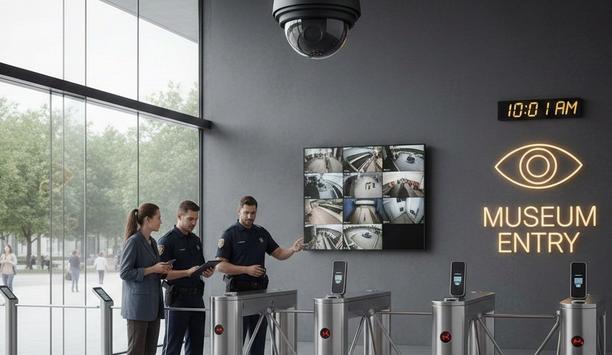Check Out Our Special Report On Casino Security
What Technology Trend Will Have The Biggest Impact On Physical Security In 2019?
- AI expected to revolutionize the physical security market in 2019.
- IoT and cloud technologies to significantly impact security trends this year.
- Expert Panel predicts transformative technology trends in security industry for 2019.
Editor Introduction
The year ahead holds endless promise for the physical security industry, and much of that future will be determined by which technologies the industry embraces. The menu of possibilities is long – from artificial intelligence to the Internet of Things to the cloud and much more – and each technology trend has the potential to transform the market in its own way. We tapped into the collective expertise of our Expert Panel Roundtable to answer this question: What technology trend will have the biggest impact on the security market in 2019?
Immediately, the connected platform comes to mind, namely Amazon, Microsoft and Google networks. In the year to come, I think they will start to impact the commercial space as well as residential. The border between commercial and consumer will become a bit blurred, as most homes are deploying smart devices manufactured by these large silos. If you trust your home with Google networks, why wouldn’t you trust your office? They’ve already tackled big areas of the cloud, so it just makes sense that the commercial space would be their next step.
Judging by current market demands and talking to providers, installers and end users across the security industry, it seems very clear that access control using mobile credentials will make a big impact in 2019. We are already seeing larger end-user organizations buying compatible readers in readiness for mobile technology-based identification. Estimates suggest that mobile identity readers are likely to make up around 10% of reader sales by 2020, so we expect to see sales snowball in 2019. Inevitably, as larger customers start using mobile credentials, this expectation will filter through to smaller organizations and the domestic security market, too. Mobile access in a home environment is already proving to be very popular, especially in the U.S., with the likes of Google promoting compatible products to appeal to domestic end users. Undoubtedly these products and services will equally appeal to end users running small businesses which have similar security needs.
IP cameras can offer users more than security. With deep learning technology and artificial intelligence (AI), cameras can be trained and can learn from properly tagged data, further benefiting the public and increasing the convenience of people’s lives. In the year 2018, there were many security companies that started to develop smart technologies. Furthermore, there are cloud-computing and edge-computing, two ways for cameras to provide data. Each of them has its own benefits: Edge-computing allows users to have real-time information and save time and cost on transferring data to the cloud, while cloud-computing is flexible and able to expand. On the other hand, any data-driven network has to contemplate its vulnerability to external cyberattacks; as a result, cybersecurity will be the highlight for the security market. Companies may release white papers or hardening guides or provide a proactive solution to control hacker attacks and achieve a more secured Internet environment.
Solution providers are building a greater technical acumen and using technology that can advance the capabilities of their products and services. Through the use of artificial intelligence, the security industry can benefit from smarter and more adaptable solutions that enable better human decision-making. We’re already seeing the use of artificial intelligence in products that provide greater situational awareness, like the differentiation between a potential intruder and a picture of a person on the wall. As artificial intelligence becomes a greater part of future solutions, we’ll see technology integrating even more into successful physical security programs.
We’re entering the world of everything’s connected and IP, with new, creative products coming from every part of the physical security landscape. The continued integration of formerly disparate products, now based on common IP protocols, and the resulting data available from systems will dramatically change the industry. Now, products are more than security. They can work together holistically to gain insights into a facility beyond safety and security. Data can assist with guaranteed reliability and uptime of all connected components across the protected premises. Analytics and historical reporting can ascertain systems are working to peak performance with no downtime. In the area of analytics, systems can be used for business process improvement, operations and even marketing, bringing critical intelligence that boosts the value of the solution and provides a lower total cost of ownership to the user. This creates a stronger value proposition for systems integrators and end users alike.
IoT (Internet of Things) will continue to make us more efficient. We’re already seeing the increased integration of IoT devices into enterprise-level solutions. The rise in city-living is also putting pressure on infrastructure, so it will become increasingly important for the truly smart and safe city to move beyond a vision into reality. As deep learning and artificial intelligence become more accurate and affordable, businesses will be keen to harness the benefits through improved efficiency and enhanced crime prevention and investigation, road safety and other health and safety applications. Cybersecurity will also remain high on the agenda. As regulators catch up, we can expect heavy fines as well as increased negative PR as big business comes under scrutiny. In turn, physical security vendors will need to ensure that their systems don’t put customers at risk. So, more investments in robust network security and education around best practices are likely.
The internet of Things and increasingly IP-connected devices will allow for greater recurring revenue streams and easier customer support. Dealers who restrict themselves to offering only traditional security will be missing out on managed services, future profitability and may lose projects to dealers that embrace the latest technologies. Forward-thinking companies who understand how to leverage the IT infrastructure, cloud computing and IP devices will be able to offer connected solutions finely tuned to the customer’s needs and can easily make system modifications when the customer’s needs change. Utilizing cloud services also removes the headache of installing and updating software on the client’s servers. Some examples of added value services include: critical environmental sensing of freezers or coolers for monitoring and compliance recordkeeping with regulations and standards; humidity sensing for museums, document room or other locations with sensitive equipment; and energy management solutions to save clients thousands on energy bills.
As increasing numbers of devices are being connected to the network, the risks of network breaches are also elevated, which is why one of the major trends in 2019 — and into the next few years — is around strengthening the cybersecurity of networked devices. All network-connected devices such as DVRs/NVRs, servers, cameras, access controllers, intrusion alarms, smart sensors and other IoT devices are vulnerable, so manufacturers will have to make a concerted effort to build cybersecurity safeguards into their products. What’s also emerging is that integrators and end users are starting to factor in cybersecurity as one of the major buying criteria for physical security hardware and software. Cyber-attacks of all kinds have become, and will continue to be, a major threat to business, making this one of the most important trends in the coming year.
AI had a colossal impact on the security industry in 2018, and we expect that to continue this year. Combined with the rise in popularity of HD and now ultra-HD video quality, surveillance solutions are recording more data than ever. According to IHS Markit, 2,500 petabytes of data are expected to be recorded every day by surveillance cameras installed in 2019. For this reason alone, video surveillance storage devices are among the most important components in surveillance systems today. Even with the help of video compression, total storage demand is rising at the rate of 280% due to the migration to 4K and the length of storage required by AI solutions. In addition to a higher sheer volume of data being recorded, we must also keep data longer for business intelligence and crime investigation purposes; thus, enhanced surveillance storage will undoubtably be a key trend in 2019.
In 2019, we’ll see an increased use of advanced technologies to improve operational efficiencies and reduce false alarms. There is an emphasis on accurate notification systems throughout the industry as stricter fines and penalties have been put in place to prevent unwarranted alarms, and first responders are continuing to evaluate the need to respond to alarms. Leveraging artificial intelligence, machine learning and video analytics bolsters existing detection and emergency notification systems in order to provide an added layer of reliability and accuracy. For example, machine learning and AI can help cross-reference detected activity with previously collected surveillance and access control data to categorize events as normal or suspicious and determine if the appropriate parties should be notified. If activity is deemed “normal,” such as maintenance entering a building after hours, it will refrain from triggering an emergency response notification. These technological advancements enable customers to better mitigate false alarms.
In 2018, we were encouraged to see the rise of “smart” IoT security devices and the role they play in deployments, both large and small. In 2019, we can only expect to see this trend pick up steam, with end users continuing to seek Big Data insights from their security solutions. With the advent and subsequent mass adoption of Ultra-HD video surveillance cameras and advanced analytics in high-end applications, end users are expecting their solutions to deliver a lot more than just security. Customers want automated and also behavioral functionality to aid in threat detection, alarm verification and real-time response. Security directors are interested in surveillance cameras with on-board analytics that yield people counting, identify objects left behind, recognize loitering, and provide reverse direction movement detection – all of which provide important business intelligence. End users are looking for “value added” services, and many manufacturers are keying into this trend.
Cloud-based solutions will continue to have a large impact across the security industry in 2019. We saw this trend dominate product offerings in the home security market throughout 2018. We expect the commercial and industrial markets to move in this direction as well, thanks to customer demand. End users are looking for more streamlined experiences, opting for applications that can be accessed remotely from mobile devices as opposed to desktop software or through a server. Dealers and integrators are seeking to increase recurring monthly revenue through managed services to drive their bottom line. These are just some of the factors driving strong adoption of hosted and web-based cloud solutions. In fact, industry research firm IHS Markit forecasts that the access-control-as-a-service market revenue will grow at a compound average growth rate (CAGR) of 16.5% between 2017 and 2022, more than double the 6.2% rate of traditional access control equipment.
As the security operations center becomes increasingly critical to an organization's security posture, there isn't a lot of attention paid to the technology trends associated with the comfort of the actual operators within these spaces. The alertness and efficiency of these operators has, arguably, the biggest impact on the protection of a facility. From my perspective, the technology trend that will have the greatest impact revolves around the technology developed to better prepare and support the control room operator themselves: human-centric lighting, technical furniture and ergonomics, as well as video walls and ancillary displays.
The answer is two-fold: increased interest and adoption of cloud-based products, as well as more investment in the recurring monthly revenue (RMR) model as a result. While slow to catch on, the idea of the cloud is becoming more popular among end users, who are seeking new ways to provide businesses a higher level of security. This technology opens a stream of revenue for manufacturers and integrators servicing small- and medium-sized businesses (SMBs) that typically haven't had the budget to invest in large-scale security solutions because of a lack of IT infrastructure to support it. As a result of the cloud, this is shifting. Along those lines, integrators are beginning to offer access-control-as-a-service (ACaaS), tapping into this model that produces RMR for the business and shifts the focus away from single, large-scale projects. This, too, has been slow to be adopted, but we're seeing more integrators embrace this option.
We will see the continued adoption of cloud-based intelligent video solutions that aggregate business data through video and artificial intelligence. Leveraging AI and IoT technologies with video data is becoming more common as organizations strive to optimize business operations while also boosting security across their facilities. The possibilities for this level of actionable intelligence gathering is endless, as markets such as hospitality, manufacturing, retail and SMEs that have multiple locations to manage look to make sense of video in intuitive, streamlined ways. The ability for technology to aggregate and analyze video surveillance and connected sensor data, identify trends in that data, and apply predictive analysis in businesses will have a huge impact in the coming year.
Editor Summary
The collective insights of our Expert Panel Roundtable point to an increased level of connectivity for security systems, encompassing the internet of things (IoT) and the cloud. There will also be an increase in system intelligence, typified by technologies such as deep learning and artificial intelligence (AI). Other trends that merited mention include mobile credentials for access control, cybersecurity, and even ergonomics. Taken individually, any one of these technologies have the potential to transform the industry. Taken together, they all but guarantee that 2019 will be a year of monumental change for the physical security marketplace, and it will come at a pace that challenges all of us – manufacturers, integrator/installers and end users – just to keep up.
Expert commentary
Security beat
The Key To Unlocking K12 School Safety Grants
DownloadHoneywell GARD USB Threat Report 2024
DownloadPhysical Access Control
DownloadThe 2024 State Of Physical Access Trend Report
DownloadThe Security Challenges Of Data Centers
DownloadKentixONE – IoT Access And Monitoring For Data Centers
Climax Technology HSGW-Gen3 Modular Smart Security Gateway
Delta Scientific DSC50 ‘S’ Barrier: Portable, Crash-Rated Vehicle Mitigation Solution


































